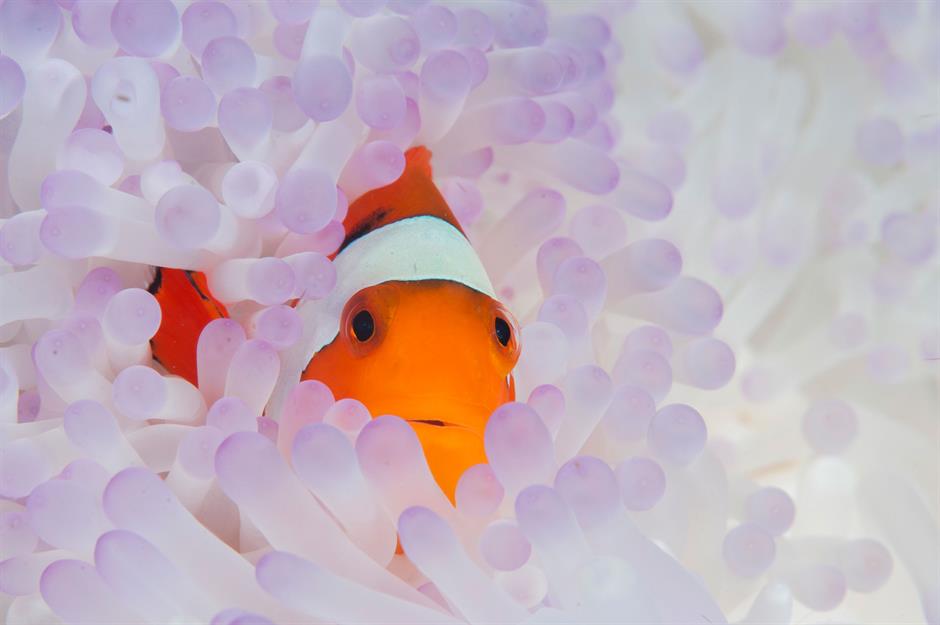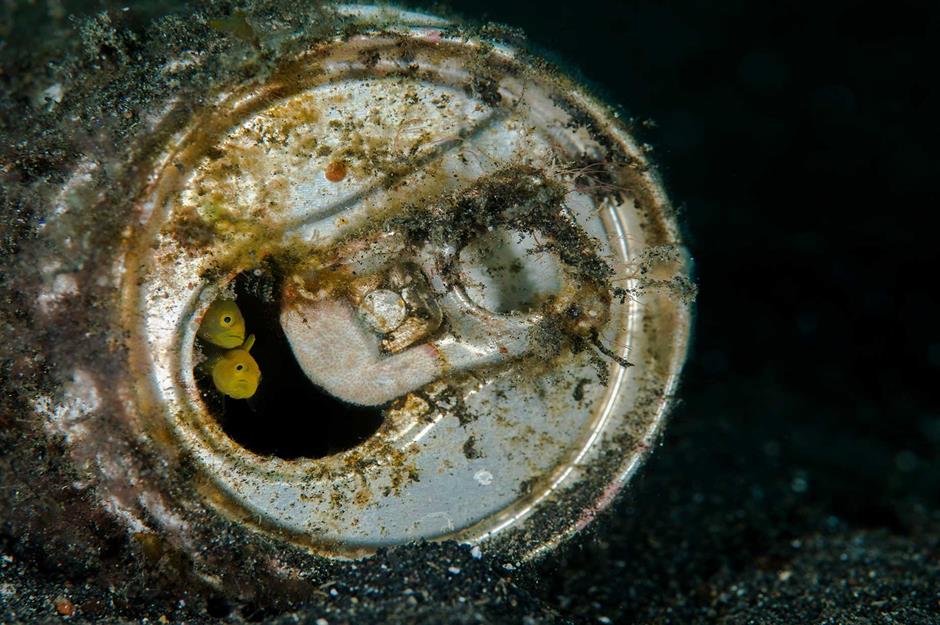Under the sea: amazing photos of the ocean's creatures

© Richard Smith – www.OceanRealmImages.com
What lies beneath
Coral reefs are home to some of the most extraordinary and little-known creatures with new discoveries still to be made. A new book, The World Beneath: The Life and Times of Unknown Sea Creatures and Coral Reefs by Dr Richard Smith, throws the spotlight on the mysteries of the intricate underwater ecosystems. “We have so much more to learn,” writes Dr Smith. “If we want to meet undiscovered organisms before we lose the chance forever, we must conserve reefs around the world.” We introduce some of the curious creatures he has encountered in his explorations…

© Richard Smith – www.OceanRealmImages.com
Golden pygmy gobies, Indonesia
Diminutive golden pygmy gobies seek shelter in an old soda can that litters the floor of a coral reef off Sulawesi. The Indonesian island is within the “Coral Triangle”, a marine region that spans parts of Indonesia, Malaysia, Papua New Guinea, the Philippines, the Solomon Islands and Timor-Leste, and has the world’s highest marine biodiversity. “Given its amazingly high biodiversity, the Coral Triangle’s conservation is a global priority,” writes Dr Smith.
© Richard Smith – www.OceanRealmImages.com
Denise’s pygmy seahorse, Indonesia
The marine biologist and photographer spent six months watching and recording the antics of the mysterious and diminutive Denise’s pygmy seahorse among the reefs of Sulawesi. The intriguing species was only recognised by science in 2003 and is very hard to find because of its size and ability to camouflage. The tiny seahorse lives on the surface of gorgonian corals.
© Richard Smith – www.OceanRealmImages.com
Denise’s pygmy seahorse, Indonesia
One of a flurry of pygmy seahorse discoveries since the beginning of the 21st century, Denise’s pygmy seahorses have different appearances because they adapt to match their home. “Some are yellow; others red, white or pink. They also vary in surface texture, from smooth to exceedingly bumpy, depending entirely on the specific gorgonian that they happen to inhabit,” writes Dr Smith.
© Richard Smith – www.OceanRealmImages.com
Denise’s pygmy seahorse, Indonesia
Here a Denise's pygmy seahorse is attached to a whip coral in Wakatobi National Park, a national marine park located southeast of Sulawesi. Like many underwater creatures, pygmy seahorses face a precarious future due to a number of threats, including demand from the Chinese traditional medicine trade. Sadly, it's estimated that some 37 million seahorses are also caught as bycatch in fishing trawlers alone each year. Take a look at the world's landmarks under threat from climate change.
© Richard Smith – www.OceanRealmImages.com
Sea slug, Solomon Islands
Molluscs also feature prominently on coral reefs, with 80% of the species-rich group belonging to the gastropoda class, which includes all manner of marine snails and slugs. This curious and colourful creature is a nembrotha kubaryana, also known as the variable neon slug.
© Richard Smith – www.OceanRealmImages.com
Blue flasher wrasse, Indonesia
The male blue flasher wrasse puts on a vibrant show in its habitat within the reefs of the Raja Ampat Islands, an archipelago in West Papua, Indonesia. Some of the most stunning of all the reef’s male displays are performed by flasher wrasses, which Dr Smith describes as "some of the most striking of all the Earth’s creatures." Indonesia alone has 11 species of these colourful reef fish in its waters.
© Richard Smith – www.OceanRealmImages.com
Walea soft coral pygmy seahorse, Indonesia
The walea soft coral pygmy seahorse is only found in the beige soft corals of one small bay in central Sulawesi, Indonesia. Its long tail, which it coils up into a ball when swimming, has adapted to hold on to the thick branches of the coral. With such a specific habitat and small natural range, the enchanting little fish is at real risk of extinction as reefs face a variety of threats including coral bleaching.
© Richard Smith – www.OceanRealmImages.com
Orangutan crab, Australia
A tiny orangutan crab sits on bubble coral in Australia’s Great Barrier Reef. So-called because of its little fine red hairs, the furry-looking crustacean measures just 0.7 inches (1.7cm) and is a decorator crab, attaching debris collected from the ocean floor to its hairs for camouflage. Discover amazing images of the world's most colourful natural wonders.
© Richard Smith – www.OceanRealmImages.com
Whale shark, Indonesia
Mysteries still shroud many of the reef's more conspicuous inhabitants including the world’s largest fish, the whale shark. “We still don’t know for sure where these behemoths go to mate or give birth. We don’t know where juveniles spend their formative years; we don’t even know where all the biggest female whale sharks live,” writes Dr Smith. The largest recorded whale shark was 65 feet (19.8m) long, twice the length of a London bus.
© Richard Smith – www.OceanRealmImages.com
Reef manta ray, the Maldives
New discoveries are unfolding on our reefs all the time. It was only in 2009 that marine researchers realised that the subtle differences seen between manta rays were actually due to there being two different species: the larger oceanic rays (mobula birostris), which tend to travel much greater distances, and the smaller, more site-attached reef manta ray species (mobula alfredi), pictured here feeding in the Maldives.
© Richard Smith – www.OceanRealmImages.com
Napoleon wrasse, Indonesia
The Napoleon wrasse is another of the largest reef fish. Also known as a humphead wrasse, due to a prominent bulge on their head, they can reach almost 7ft 6 inches (2.28m) in length. The green colours of this one, pictured in the Raja Ampat Islands, allows it to blend into the mid-water tones to catch a damselfish. Sadly, the majestic creatures are considered a luxury food and are now listed as endangered due to the threat they face from the live reef fish market.
© Richard Smith – www.OceanRealmImages.com
Sand tigers, Australia
Here sand tigers shelter in a cave off the coast of New South Wales. Also known as grey nurse sharks, the species likes shallow water close to shore and is the only shark species which swims to the water's surface to gulp air to regulate its buoyancy. Sadly, the docile species is critically endangered and now a protected species. Like many coral reef fish, the shark's population has been threatened not only by overfishing, but also by destructive fishing methods.
© Richard Smith – www.OceanRealmImages.com
Anemonefish, Indonesia
It's not all glitz and glamour on tropical reefs, parasites are also common. Pictured here is an anemonefish with a tongue-biter attached to its tongue. The macabre isopod crawls through the gill arches when it's small and into the fish’s mouth where it gradually devours its host's tongue to take its place. The fish can use the new tongue-shaped parasite as a prosthetic to grip and swallow prey, but it’s often so big that the fish can't close its mouth. Now take a look at the underwater cities we've only just discovered.
© Richard Smith – www.OceanRealmImages.com
A hogfish meets its maker, the Philippines
Masters of disguise, frogfishes are among the ugliest and cleverest of sea creatures. Here, a hidden frogfish confronts a tiny juvenile hogfish in a reef off the Philippines’ Negros Island. Frogfishes have long rod-like lures that they cast out from the forehead to coax hapless fish close before sucking them inside their wide mouths.
© Richard Smith – www.OceanRealmImages.com
Juvenile boxfish, Philippines
Colour plays a huge role in the hierarchy of the reef with juvenile reef fish often having completely different colours, patterns and even body shapes compared to mature adults. It's so when they arrive on the reef, adults don’t see them as competitors for food and other resources. This spotty juvenile boxfish, the size of a dice, was photographed on a reef off the island of Luzon in the Philippines.
These are the world's most colourful places
© Richard Smith – www.OceanRealmImages.com
Clownfish in anemone, Indonesia
The clownfish is one of the most recognisable reef dwellers and the best known of the anemonefish species, thanks to its starring role in Pixar’s Finding Nemo. Thirty different anemonefish are found throughout the tropical Indo-Pacific region, where they live and shelter among the tentacles of anemones. These stinging polyps are highly vulnerable to increases in the frequency and severity of coral bleaching events, which also puts the health of their residents in great jeopardy.
Discover the world's most beautiful natural wonders
Courtesy of Apollo Publishers
Find out more
All images were taken with permission from the book The World Beneath: The Life and Times of Unknown Sea Creatures and Coral Reefs by Dr Richard Smith, published by Apollo Publishers, and available via Amazon and in all good bookshops.

